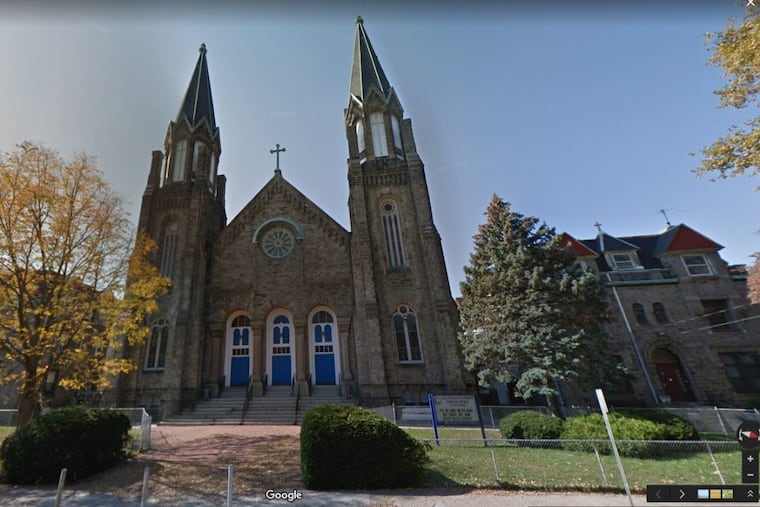Ghosts of Philly's Catholic Past | Frank's Place
Sadly, many have vanished in recent decades, their abandoned churches and schools now tombstones in a changing city. And as these parishes disappear, a lot of Philadelphia sports history is disappearing with them.

The train to Chartres had finally reached the point where that French village became visible, where the breathtaking 800-year-old cathedral loomed like a stone colossus over a Lilliputian world, where its soaring, mismatched spires looked as if they could puncture a perfect blue sky.
"Can you see it?" my wife said softly.
"Wow," I replied. "It looks like Our Mother of Sorrows in West Philly."
Parishes are the Rosetta stones that explain existence to Philadelphia Catholics. They reveal one's demographic DNA. Each has a unique story to tell – about its history, its neighborhood, the sports played there, and the athletes who excelled at them.
Many have vanished in recent decades, their abandoned churches and schools now tombstones in a changing city. And as these parishes disappear, a lot of Philadelphia sports history is disappearing with them.
That story from our 1993 trip to Chartres has been in my head recently, ever since I read that the spectacular Our Mother of Sorrows church would officially close this week.
If you've entered Philadelphia from the west on a commuter train, you've probably seen its towering twin spires and vaulted apse. Dominating the skyline in a West Philadelphia neighborhood called Mill Creek, it was the glorious centerpiece in a cluster of Catholic institutions near 48th and Lancaster — Cathedral Cemetery, St. Thomas More High School, St. John's Orphanage.
"When I take the train into the city, it makes me tear up to look over there and see it," said Jim Murray, a former parishioner who became the Eagles' general manager. "It breaks your heart. It was a part of our souls."
The grand church rose between 1867 and 1870. For nearly a century, as in medieval Europe, it was the heart of a neighborhood that, as one local historian noted, "was wall-to-wall rowhouse Catholics."
Its school, run by the Sisters of St. Joseph, grew and prospered until by 1936 it was bursting with 1,185 students. As open space disappeared, Our Mother of Sorrows' schoolyard became the neighborhood's playground.
"It was the center of everything for us," Murray said. "We played all our games there — pimple ball, stick ball, box ball. Our football was a rolled-up newspaper held together with rubber bands. We were just kids who loved sports and improvised."
One of the first parishioners to reach the sports headlines did so tragically. Louis McBride, 23, of Brown Street, was one of 12 Phillies fans who died when Baker Bowl's grandstands collapsed on Aug. 8, 1903.
Our Mother of Sorrows was unusual for an inner-city parish in that it had a freestanding gymnasium. Consequently, basketball played a huge role in its story.
Billy Hoy, a backcourt star on the Jack Ramsay-coached St. Joseph's team that made it to the Final Four in 1961, was a prototypical Mother of Sorrows product. So was Ju'Quan Newton, who at Neumann-Goretti High became the Catholic League's all-time scoring leader. And one of the youngsters who played there in the 1980s, Kenny Caldwell, died in the 9/11 attacks.
In 2010, with Newton its star, the parish team, coached by alumnus Leroy Duncan, won the state CYO title with a 41-0 record.
"We've always had good basketball here, even after the [2009] merger with St. Ignatius," said Sister Owen Patricia, principal of the combined school located at St. Ignatius. "We've won several regional and state CYO championships. It's the tradition that's kept it going."
And it wasn't just Mother of Sorrows boys.
In the 1920s, several girls took up basketball under the guidance of a parish priest, Father Gorman. They became so proficient that, calling themselves the Milkmaids, they won 91 consecutive games and, according to a 1925 Inquirer story, "a women's world championship."
The Mother of Sorrows' gym also served as home to the Shanahan Catholic Club, a vibrant social organization that sponsored various sports. Its boxing program, for example, turned out quality fighters, many of whom were featured on the Middle Atlantic AAU fight cards regularly held there.
Murray, of course, and his brother, Fran, ended up in pro football administration. Another, unrelated Murray from Mother of Sorrows, Franny, was a star halfback and punter at Penn and played two seasons (1939-40) with the Eagles.
Change began in the 1950s, when "white flight" drew parishioners to the suburbs and the new, mostly African American residents tended to be Protestants.
Alumni, especially those who'd play sports there, tried to keep the struggling parish afloat with fund-raisers and their own mailed donations.
One donor, Sister Owen Patricia recalled, included with his check a newspaper clipping that detailed Our Mother of Sorrows championship in St. Thomas More's 1948 Christmas basketball tournament. He likely was more reluctant to part with that than with the money.
Murray's family was among those who moved away in the 1950s. But he never lost the connection to his boyhood parish.
On the morning of Jan. 11, 1981, with his Eagles about to face Dallas in the NFC championship game at Veterans Stadium, Murray and a friend – Bob Ellis, father of CSN Philly's Rob Ellis — drove to Our Mother of Sorrows.
"We asked the nuns to let us in," Murray said, "and, just like we did when we were kids and wanted something, we said a few Hail Marys."
The Eagles beat the Cowboys, 20-7.
"That place was where our love of sports came from," Murray said. "Our Mother of Sorrows planted some good seeds. We were blessed beyond words. It's hard to define it to people. But the people who lived it understand."
All throughout the city, in the hollowed-out shells of once vibrant institutions, Philadelphia's sports ghosts know exactly what he meant.